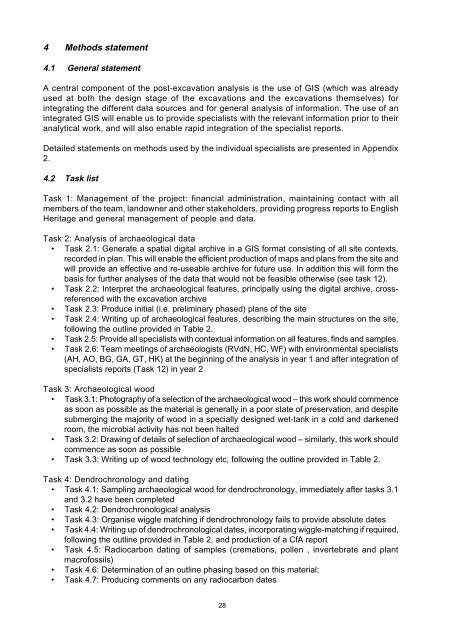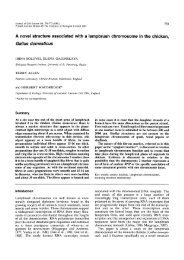Sutton Common Updated project design - University of Exeter
Sutton Common Updated project design - University of Exeter
Sutton Common Updated project design - University of Exeter
You also want an ePaper? Increase the reach of your titles
YUMPU automatically turns print PDFs into web optimized ePapers that Google loves.
4 Methods statement<br />
4.1 General statement<br />
A central component <strong>of</strong> the post-excavation analysis is the use <strong>of</strong> GIS (which was already<br />
used at both the <strong>design</strong> stage <strong>of</strong> the excavations and the excavations themselves) for<br />
integrating the different data sources and for general analysis <strong>of</strong> information. The use <strong>of</strong> an<br />
integrated GIS will enable us to provide specialists with the relevant information prior to their<br />
analytical work, and will also enable rapid integration <strong>of</strong> the specialist reports.<br />
Detailed statements on methods used by the individual specialists are presented in Appendix<br />
2.<br />
4.2 Task list<br />
Task 1: Management <strong>of</strong> the <strong>project</strong>: financial administration, maintaining contact with all<br />
members <strong>of</strong> the team, landowner and other stakeholders, providing progress reports to English<br />
Heritage and general management <strong>of</strong> people and data.<br />
Task 2: Analysis <strong>of</strong> archaeological data<br />
• Task 2.1: Generate a spatial digital archive in a GIS format consisting <strong>of</strong> all site contexts,<br />
recorded in plan. This will enable the efficient production <strong>of</strong> maps and plans from the site and<br />
will provide an effective and re-useable archive for future use. In addition this will form the<br />
basis for further analyses <strong>of</strong> the data that would not be feasible otherwise (see task 12).<br />
• Task 2.2: Interpret the archaeological features, principally using the digital archive, crossreferenced<br />
with the excavation archive<br />
• Task 2.3: Produce initial (i.e. preliminary phased) plans <strong>of</strong> the site<br />
• Task 2.4: Writing up <strong>of</strong> archaeological features, describing the main structures on the site,<br />
following the outline provided in Table 2.<br />
• Task 2.5: Provide all specialists with contextual information on all features, finds and samples.<br />
• Task 2.6: Team meetings <strong>of</strong> archaeologists (RVdN, HC, WF) with environmental specialists<br />
(AH, AO, BG, GA, GT, HK) at the beginning <strong>of</strong> the analysis in year 1 and after integration <strong>of</strong><br />
specialists reports (Task 12) in year 2<br />
Task 3: Archaeological wood<br />
• Task 3.1: Photography <strong>of</strong> a selection <strong>of</strong> the archaeological wood – this work should commence<br />
as soon as possible as the material is generally in a poor state <strong>of</strong> preservation, and despite<br />
submerging the majority <strong>of</strong> wood in a specially <strong>design</strong>ed wet-tank in a cold and darkened<br />
room, the microbial activity has not been halted<br />
• Task 3.2: Drawing <strong>of</strong> details <strong>of</strong> selection <strong>of</strong> archaeological wood – similarly, this work should<br />
commence as soon as possible<br />
• Task 3.3: Writing up <strong>of</strong> wood technology etc, following the outline provided in Table 2.<br />
Task 4: Dendrochronology and dating<br />
• Task 4.1: Sampling archaeological wood for dendrochronology, immediately after tasks 3.1<br />
and 3.2 have been completed<br />
• Task 4.2: Dendrochronological analysis<br />
• Task 4.3: Organise wiggle matching if dendrochronology fails to provide absolute dates<br />
• Task 4.4: Writing up <strong>of</strong> dendrochronological dates, incorporating wiggle-matching if required,<br />
following the outline provided in Table 2, and production <strong>of</strong> a CfA report<br />
• Task 4.5: Radiocarbon dating <strong>of</strong> samples (cremations, pollen , invertebrate and plant<br />
macr<strong>of</strong>ossils)<br />
• Task 4.6: Determination <strong>of</strong> an outline phasing based on this material;<br />
• Task 4.7: Producing comments on any radiocarbon dates<br />
28
















